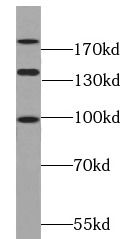Products
PARD3 antibody
| Synonyms: | Partitioning defective 3 homolog (PAR-3 antibody, PARD-3)|Atypical PKC isotype-specific-interacting protein (ASIP)|CTCL tumor antigen se2-5|PAR3-alpha|PARD3|PAR3|PAR3A antibody | ||
| Catalogue No.: | FNab06146 | Reactivity: | Human, Mouse, Rat |
| Host: | Rabbit | Tested Application: | ELISA, WB, IHC, FC, IP |
| Clonality: | polyclonal | Isotype: | IgG |
| Size | Price |
|---|---|
| 100µg | Inquiry |
- SPECIFICATIONS
- FIGURES
- CONDITIONS
- FAQS
- Product Name
- PARD3 antibody
- Catalogue No.
- FNab06146
- Size
- 100μg
- Form
- liquid
- Purification
- Immunogen affinity purified
- Purity
- ≥95% as determined by SDS-PAGE
- Clonality
- polyclonal
- Isotype
- IgG
- Storage
- PBS with 0.02% sodium azide and 50% glycerol pH 7.3, -20℃ for 12 months(Avoid repeated freeze / thaw cycles.)
- Immunogen
- Partitioning defective 3 homolog
- Alternative Names
- Partitioning defective 3 homolog (PAR-3 antibody, PARD-3)|Atypical PKC isotype-specific-interacting protein (ASIP)|CTCL tumor antigen se2-5|PAR3-alpha|PARD3|PAR3|PAR3A antibody
- UniProt ID
- Q8TEW0
- Observed MW
- 100 kDa, 150 kDa, and 180 kDa
- Tested Applications
- ELISA, WB, IHC, FC, IP
- Recommended dilution
- WB: 1:500-1:1000; IP: 1:200-1:1000; IHC: 1:50-1:200; IF: 1:50-1:500
 MCF7 cells were subjected to SDS PAGE followed by western blot with FNab06146(PARD3 antibody) at dilution of 1:500
MCF7 cells were subjected to SDS PAGE followed by western blot with FNab06146(PARD3 antibody) at dilution of 1:500
 IP Result of anti-PARD3 (IP:FNab06146, 4ug; Detection:FNab06146 1:200) with MCF-7 cells lysate 2900ug.
IP Result of anti-PARD3 (IP:FNab06146, 4ug; Detection:FNab06146 1:200) with MCF-7 cells lysate 2900ug.
 Immunohistochemistry of paraffin-embedded human colon cancer using FNab06146(PARD3 antibody) at dilution of 1:50
Immunohistochemistry of paraffin-embedded human colon cancer using FNab06146(PARD3 antibody) at dilution of 1:50
 Immunofluorescent analysis of fixed MCF-7 cells using FNab06146 (PARD3 antibody) at dilution of 1:50 and Alexa Fluor 488-conjugated Goat Anti-Rabbit IgG(H+L)
Immunofluorescent analysis of fixed MCF-7 cells using FNab06146 (PARD3 antibody) at dilution of 1:50 and Alexa Fluor 488-conjugated Goat Anti-Rabbit IgG(H+L)
- Background
- Adapter protein involved in asymmetrical cell division and cell polarization processes. Seems to play a central role in the formation of epithelial tight junctions. Targets the phosphatase PTEN to cell junctions. Involved in Schwann cell peripheral myelination(By similarity). Association with PARD6B may prevent the interaction of PARD3 with F11R/JAM1, thereby preventing tight junction assembly. The PARD6-PARD3 complex links GTP-bound Rho small GTPases to atypical protein kinase C proteins. Required for establishment of neuronal polarity and normal axon formation in cultured hippocampal neurons.PARD3 has three splice isoforms at 100 kDa, 150 kDa, and 180 kDa. This polyclonal antibody raised against C-terminal 281 amino acids of human PARD3 recognizes these three isoforms.
How many times can antibodies be recycled?
First, usually it's not suggested to recycle antibodies. After use, buffer system of antibodies has changed. The storage condition of recycled antibodies for different customers also varies. Thus, the performance efficiency of recycled antibodies can’t be guaranteed. Besides, FineTest ever conducted the antibody recycling assay. Assay results show recycling times of different antibodies also varies. Usually, higher antibody titer allows more repeated use. Customers can determine based on experimental requirements.
Notes: After incubation, we recycle rest antibodies to centrifuge tube and store at 4℃. High titer antibodies can be stored for a minimum of one week. Reuse about three times.
What are components of FineTest antibody buffer?
Components of FineTest antibody buffer are usually PBS with proclin300 or sodium azide, BSA, 50% glycerol. Common preservative is proclin300 or sodium azide, which is widely applied in the lab and industry.
How about the storage temperature and duration of FineTest antibodies?
Most antibodies are stored at -20℃. Directly-labeled flow cytometry antibodies should be stored at 2 - 8℃. The shelf life is one year. If after sales issues for purchased antibodies appear, return or replacement is available. Usually, antibodies can be still used after the one-year warranty. We can offer technical support services.
Is dilution required for FineTest antibodies? What’s the dilute solution?
Directly-labeled flow cytometry antibodies are ready-to-use without dilution. Other antibodies are usually concentrated. Follow the dilution ratio suggested in the manual. Dilute solution for different experiments also varies. Common antibody dilution buffers are acceptable(e.g. PBST, TBST, antibody blocking buffer).
How to retrieve antibodies for immunohistochemistry?
Common retrieval buffers: Tris-EDTA Buffer(pH 9.0); Citrate Buffer(pH 6.0)
Heat induced antibody retrieval:
Method 1: Water-bath heating: Put the beaker with retrieval buffer and slide in the boiling water bath. Keep the boiling state for 15min. Naturally cool to room temperature;
Method 2: Microwave retrieval: Put the beaker with retrieval buffer and slide in the microwave oven. Heat at high power for 5min, Switch OFF for 3min, Heat at medium power for 5min. Naturally cool to room temperature.
How to choose secondary antibodies?
(1) Secondary antibodies react with primary antibodies. Thus, secondary antibodies should be against host species of primary antibodies. E.g. If the primary antibody is derived from rabbit, the relevant secondary antibody should be against rabbit. E.g. goat anti rabbit or donkey anti rabbit.
(2) Choose secondary antibody conjugates according to the experimental type, e.g. ELISA, WB, IHC etc. Common enzyme conjugated secondary antibodies are labelled by HRP, AP etc. Fluorescin or dye labelled secondary antibodies are applied in immunofluorescence and flow cytometry(e.g. FITC, Cy3).
